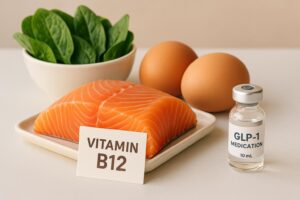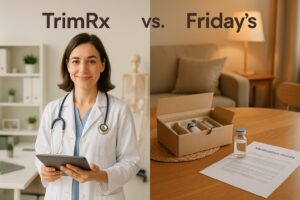How to Eat on GLP-1: A Comprehensive Guide for Healthier Living

Introduction
Did you know that nearly 42% of adults in the United States are classified as overweight or obese? This staggering statistic underscores the importance of effective weight management strategies, particularly as health issues related to obesity become more prevalent. For many individuals, medications like GLP-1 (glucagon-like peptide-1) agonists such as Ozempic, Wegovy, and Mounjaro have emerged as powerful tools in the battle against weight gain. These drugs not only assist in weight loss but also play a crucial role in managing blood sugar levels, particularly for those with type 2 diabetes.
As we delve into the intricacies of how to eat while on GLP-1 medications, we’ll explore the essential dietary adjustments that can enhance the effectiveness of these drugs. Our goal is to provide you with actionable insights and practical tips that will help you embrace a healthier lifestyle—one that is sustainable and tailored to your unique needs.
In this blog post, we will cover:
- An overview of GLP-1 medications and how they work
- The importance of nutrition while on GLP-1
- Foods to embrace and avoid
- Meal planning strategies for success
- Tips for managing side effects
- How TrimRx’s personalized weight loss solutions can support your journey
By the end of this post, you will have a comprehensive understanding of how to navigate your dietary choices while taking GLP-1 medications, ensuring that you not only lose weight but also maintain your overall health and well-being.
Understanding GLP-1 Medications
GLP-1 medications are a class of drugs designed to mimic the natural hormone glucagon-like peptide-1, which is produced in the intestines. This hormone plays a pivotal role in appetite regulation, insulin secretion, and slowing gastric emptying. By activating the GLP-1 receptors, these medications help reduce hunger, increase the sensation of fullness, and promote better blood sugar control.
In addition to their effectiveness in weight loss, it’s essential to understand the potential side effects which might include nausea, vomiting, and gastrointestinal discomfort. These side effects can often be managed through dietary modifications, making it crucial to focus on what and how you eat.
The Importance of Nutrition While on GLP-1
When taking GLP-1 medications, what you consume becomes even more critical. The medications reduce appetite and, as a result, may lead to lower caloric intake. While this can aid in weight loss, it also raises concerns about ensuring adequate nutritional intake.
Nutritional Needs
To support your body effectively while on GLP-1s, it’s vital to prioritize nutrient-dense foods that provide essential vitamins, minerals, and macronutrients. A balanced diet will not only help you maintain your weight loss but also ensure that you do not suffer from nutrient deficiencies. Here are some key areas to focus on:
- Protein: Essential for muscle maintenance and overall health, protein should be a priority in your meals. Aim for lean sources such as chicken, fish, legumes, and plant-based proteins like tofu and tempeh.
- Fiber: Fiber-rich foods can aid digestion, stabilize blood sugar levels, and promote feelings of fullness. Include a variety of fruits, vegetables, and whole grains in your diet.
- Hydration: Staying well-hydrated is essential, especially since GLP-1 medications can lead to dehydration. Aim for at least 64 ounces of water daily, and consider adding herbal teas or sugar-free beverages for variety.
Foods to Embrace on GLP-1
When considering how to eat on GLP-1 medications, certain foods can enhance your experience and support your health goals. Here’s a list of foods to prioritize:
Lean Proteins
- Chicken and Turkey: Grilled, baked, or roasted lean poultry is an excellent source of protein.
- Fish: Fatty fish like salmon and mackerel are rich in omega-3 fatty acids, promoting heart health.
- Legumes: Beans, lentils, and chickpeas are great plant-based protein options, packed with fiber.
Non-Starchy Vegetables
- Leafy Greens: Spinach, kale, and arugula are nutrient-dense and low in calories.
- Cruciferous Vegetables: Broccoli, cauliflower, and Brussels sprouts are high in fiber and vitamins.
Whole Grains
- Quinoa and Brown Rice: These whole grains provide sustained energy and are rich in nutrients.
- Oats: A great breakfast option, oats are filling and high in fiber.
Healthy Fats
- Avocados: Packed with monounsaturated fats, avocados can help improve satiety.
- Nuts and Seeds: Almonds, walnuts, chia seeds, and flaxseeds offer healthy fats and protein.
Fruits (in Moderation)
While fruits are essential for their vitamins and minerals, it’s advisable to choose lower-sugar options and consume them in moderation. Consider berries, apples, and citrus fruits.
Foods to Avoid on GLP-1
Just as important as knowing what to eat is understanding what to limit or avoid entirely. Certain foods may exacerbate side effects or hinder the effectiveness of GLP-1 medications:
High-Fat and Processed Foods
- Fast Food: Often high in unhealthy fats and sugars, fast food can lead to gastrointestinal discomfort.
- Fried Foods: These can slow digestion further and exacerbate nausea.
Sugary Foods and Beverages
- Sodas and Sweetened Drinks: High in sugar and calories, these can spike blood sugar levels and lead to cravings.
- Candy and Desserts: Limit these to maintain stable energy levels and minimize excess caloric intake.
Starchy Vegetables and Fruits
- Potatoes, Corn, and Peas: High in carbohydrates, these should be consumed in moderation.
- Bananas and Pineapples: While nutritious, these fruits can be higher in sugar, so consider portion sizes.
Meal Planning Strategies for Success
Effective meal planning is an essential component of how to eat on GLP-1 medications. With the potential for reduced appetite and altered eating patterns, having a structured approach can help ensure you get the nutrients you need.
Create Balanced Meals
Aim for meals that include a source of protein, a variety of vegetables, and a healthy fat. For instance, a grilled chicken salad topped with avocado and a variety of colorful veggies is not only nutritious but also visually appealing.
Smaller, Frequent Meals
Given that GLP-1 medications can suppress appetite, consider having smaller, more frequent meals throughout the day to meet your nutritional needs without overwhelming your stomach.
Prepare Ahead
Batch cooking or preparing meals in advance can save time and reduce the temptation to opt for less healthy options. Consider dedicating a day each week to meal prep.
Listen to Your Body
Learning to listen to your body’s hunger cues is crucial. Even if you’re not feeling particularly hungry, ensure you are consuming nutrient-dense foods regularly to prevent malnutrition.
Managing Side Effects
It’s not uncommon for individuals on GLP-1 medications to experience side effects such as nausea or gastrointestinal discomfort. Here are some strategies to manage these effects through diet:
- Start with Bland Foods: If you’re feeling nauseous, begin with bland foods such as toast, rice, or crackers until your symptoms improve.
- Avoid Spicy Foods: These can aggravate gastrointestinal distress, so it’s best to steer clear.
- Stay Hydrated: As mentioned earlier, drinking enough water is vital, especially if you experience side effects.
How TrimRx Supports Your Weight Loss Journey
At TrimRx, we understand that navigating your weight loss journey can be challenging, especially when incorporating GLP-1 medications into your routine. Our mission is to provide personalized, medically supervised care that empowers you to achieve sustainable weight loss.
Our approach includes:
- Personalized Assessment: Take our free assessment quiz to determine your eligibility for prescription weight loss medications like Semaglutide and Tirzepatide. This personalized touch ensures that we cater to your unique needs and goals. Take the quiz here.
- Ongoing Support: We offer unlimited support throughout your weight loss journey, ensuring you have the resources and encouragement needed to succeed.
- Quick-Access Supplements: Our GLP-1 Daily Support and Weight Loss Boost supplements are designed to complement your diet and enhance your weight loss efforts. Explore our GLP-1 Daily Support and check out Weight Loss Boost.
Conclusion
Understanding how to eat on GLP-1 medications is an essential part of maximizing their effectiveness and ensuring a healthier lifestyle. By prioritizing nutrient-rich foods, managing potential side effects, and implementing thoughtful meal planning strategies, you can navigate your weight loss journey successfully.
At TrimRx, we are committed to supporting you every step of the way. Together, we can make sustainable weight loss attainable through science, empathy, and personalized care.
FAQ
Can I eat whatever I want while on GLP-1 medications?
While there are no strict food restrictions, focusing on nutrient-dense foods and avoiding high-fat, processed, and sugary options will help you get the most out of your medication.
How much protein should I consume daily on GLP-1?
Aim for at least 60 grams of protein daily. This will help maintain muscle mass, especially during weight loss.
What should I do if I forget to eat while on GLP-1?
If you’re not feeling hungry, try to remind yourself to eat small, nutritious meals throughout the day to prevent malnutrition.
Is it necessary to consult a dietitian while on GLP-1?
Consulting with a registered dietitian can help tailor your eating plan to your specific needs and ensure you are meeting your nutritional goals.
How can TrimRx help me on my weight loss journey?
TrimRx offers personalized assessments, ongoing support, and access to quick-access supplements to complement your weight loss efforts while taking GLP-1 medications.
By following these guidelines, we can embrace our health and make informed dietary choices that support our weight loss journey. Let’s take the next step together!

Transforming Lives, One Step at a Time
Keep reading
Vitamin B12 and GLP-1 Medications: What to Know
GLP-1 medications can lower B12 absorption and intake; learn symptoms, food sources, supplement options, and how to monitor levels.
Semaglutide Injection Site Reactions: What To Know
Learn why semaglutide injections can cause redness, swelling or nodules, how to prevent and treat them, and when to seek medical care.
TrimRx vs Friday’s
Compare TrimRx and Friday’s telehealth GLP-1 weight-loss programs: pricing, medical support, coaching, delivery, and which fits your needs.



